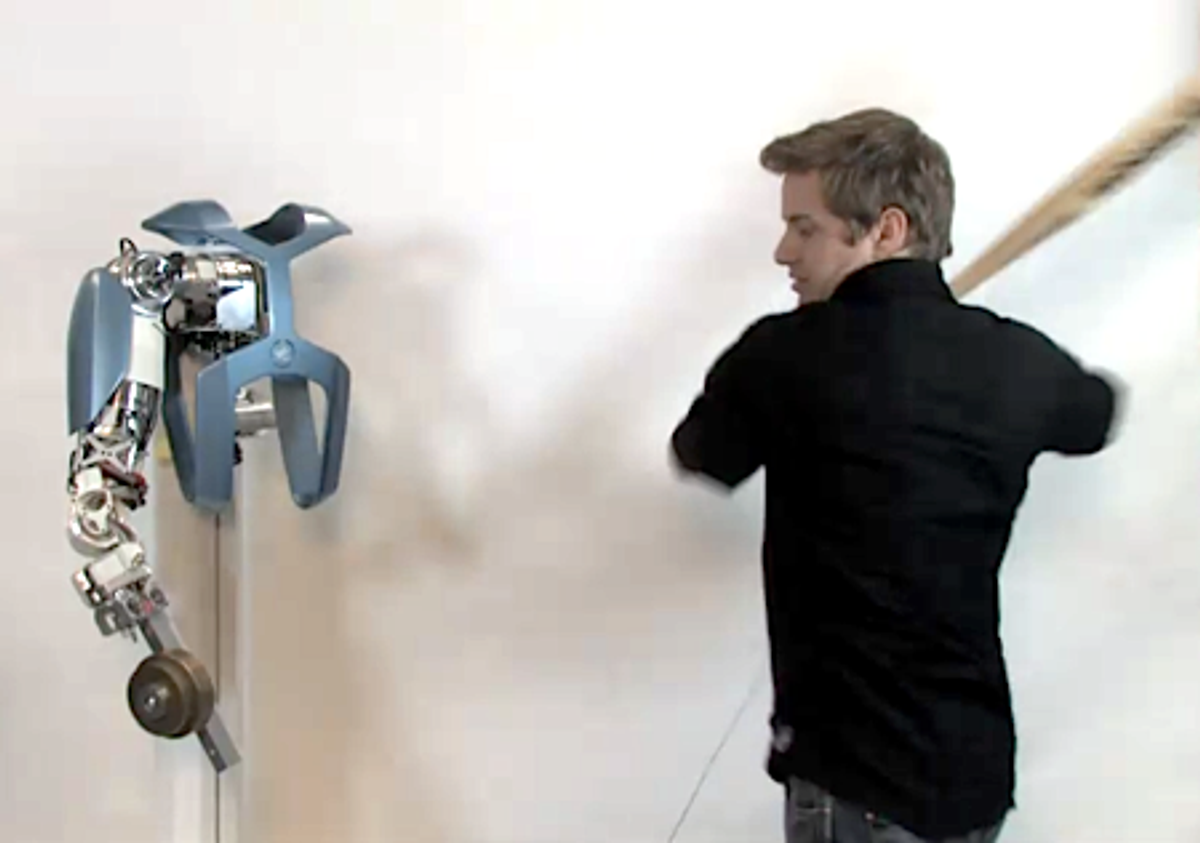Why is this man about to smash his robot with a bat?
Don't worry. It's just another day at the German Aerospace Center (DLR), where researchers have built what's probably the most advanced -- and tough -- robotic arm ever. And they aren't afraid of testing its limits.
It's called the DLR Hand Arm System [photo, below]. It has an anthropomorphic design and packs 52 motors, ultra-miniaturized control electronics, a supercapacitor-based power supply, and a web of synthetic tendons stronger than Kevlar. But what makes it stand out compared to conventional systems is its ability to withstand collisions, thanks to ingeniously designed joints and actuators that can absorb and dissipate energy, much like our own arms and hands do.
Which brings us to their latest test with the aforementioned wooden bat. The DLR researchers are known for their bold experiments. They've equipped a robot with a knife and tested a stabbing-avoidance algorithm on themselves. They've used massive industrial manipulators to mercilessly destroy crash test dummies. Last year, they demonstrated that their super-strong robot hand could endure a beating from a hammer. (Blogs promptly dubbed it the "Terminator hand.")
This time, they wanted to assess the robustness of the upper arm and shoulder. Would it still work after a violent collision? There was only one way to find out:
Did you notice how, after getting struck, the arm gently touches the yellow ball, exactly as it had done before? That's to show that its mechanisms and electronics are as good as new. If I could design a robot like this, I would be grinning just like the guy in the video.
The researchers, members of DLR's Institute of Robotics and Mechatronics, described the overall system in detail for the first time today at the IEEE International Conference on Robotics and Automation (ICRA), in Shanghai.
Markus Grebenstein, the Hand Arm System's lead designer, tells me that robustness is essential if we want to deploy service robots in the real world, where collisions are likely to happen. Even small shocks, he says, can damage conventional robots, which rely on motors coupled to joins in mechanically stiff configurations.
This means that, in a collision, shock and vibration will spread through these rigid structures and, because they lack a mechanism to dissipate the energy, they will tear themselves apart. Even newer impedance control techniques, which lets robots move compliantly when a person or object pushes on them, can't help in collision situations, because feedback controllers and motors aren't fast enough.
The DLR team noticed this limitation in its own robots. One of them, Justin, is able to catch a ball thrown at him -- and even two balls at once -- most of the time. But in some cases, when the robot computed an inaccurate trajectory for the ball, it might stretch its fingers completely and the 80-gram ball, upon hitting the fingertips, would damage the hand. By comparison, a handball goalkeeper withstands the impact of a 480-gram ball moving at 120 kilometers per hour, or nearly five times as fast, and delivering 100 times as much energy.
And why vary the stiffness of the fingers anyway? Because different situations demand different levels of stiffness. If you embed lots of springs and other shock-absorbing structures into your arm system, it will be able to withstand collisions, but when you try to pick a grape on a table it will vibrate and fail.
By varying its stiffness, the DLR system can perform well both in terms of robustness and accuracy. And it can perform tasks that other robots would have difficulty doing, such as using a hammer to drive nails on a wooden board. Watch:
The complete Hand Arm System is an engineering masterpiece. The shoulder has 3 degrees of freedom, and the elbow has 1 DoF. Each hand alone has 19 DoF, with two additional DoF on the wrist, which uses a "spherical antiparallelogram mechanism" powered by four motors, allowing for 30-degree side motion and 90-degree flexion/extension.
I mean, just look at this thing [photo, below]. It's crammed with motors, electronics, and cables, and yet it can endure vicious mechanical abuse without losing performance.
Now, it would be nice to see more dexterous manipulations. Can the DLR hand grasp objects of various sizes and shapes? Can you put two arms together and perform bimanual manipulations? Can a person wearing a sensor suit teleoperate the robot as the same DLR team has demonstrated with Justin?
I suspect the researchers will be working on some of these capabilities in the near future. One thing is certain, though: Expect more awesome videos from these guys. (UPDATE: As if to tease me, Grebenstein just send me the photos below.)
Updated May 13: Corrected explanation of Justin catching balls; added more photos.
Images and videos: DLR/IEEE Spectrum
READ ALSO:
Blog Post: What would happen if a knife-wielding robot struck a person?
Blog Post: Quadrotors performing acrobatics, ultrarealistic humanoids dancing, dexterous robots folding towels, and more
Blog Post: An ambitious four-year program aims at transforming robotic manipulation from art into science
Blog Post: German researchers have developed robotic eyes that move at superhuman speeds
Erico Guizzo is the Director of Digital Innovation at IEEE Spectrum, and cofounder of the IEEE Robots Guide, an award-winning interactive site about robotics. He oversees the operation, integration, and new feature development for all digital properties and platforms, including the Spectrum website, newsletters, CMS, editorial workflow systems, and analytics and AI tools. An IEEE Member, he is an electrical engineer by training and has a master’s degree in science writing from MIT.















